Table of Contents
Creating assessment activities for your educational content is an excellent way to test your learner’s knowledge and progress. Assessments help you achieve the learning outcomes you set for each learning program or curriculum. In doing so, they also determine the degree to which each learning goal has been met, allowing you to evaluate how valuable your course is for your learners.
However, how do you, as an instructor, design assessments in online learning in the context of creating powerful online learning content?
When building online courses, most instructors choose to provide a final quiz at the end of their course and a passing score accompanied by a certificate. This is a good start with assessments, but is it enough? Probably not.
Any assessment of learning works best when it is ongoing, not episodic. A continuous, and more advanced assessment method that focuses on student work, can highlight student achievement and progress. When an effective assessment is in place, it improves students’ understanding of the taught subject and helps them become more aware of the abilities they gain throughout the course.
Harasim, Hiltz, Teles, & Turoff (1996, p. 167) support that:
This assumption brings a lot to the table, which we will discuss here.
In this article, we explore what learner assessment is, learn about its best practices, and figure out ways you can embed it into your online course.
Table of contents
1What is Learner Assessment?
Learner assessment or assessment for learning– AFL refers to the process of gathering essential data on students’ knowledge, skills, and understanding to complement teaching. As a fundamental approach to teaching and learning, AFL creates valuable feedback that is ultimately used to help students improve their performance.
The purpose of learner assessment is to close the gap between where the student currently is and where they want to be in their learning journey.
AFL enables active learning in an attempt to get students more involved in the learning process, allowing them to reach their achievement goals.
Learner assessments are easily integrated into any educational environment – whether it is online or offline – and can be adjusted to suit any age group and ability. This means that it can also apply to online corporate programs through online training assessments.
2The Importance of Learner Assessment
Assessments are undoubtedly one of the most important aspects of effective instruction, and they are equally important from both a learner’s and an instructor’s point of view.
Not only do they help to test the students’ knowledge, but they also allow online instructors to conduct online classes more effectively.
Assessment of learning is therefore important for instructors to:
Educators can more easily gauge students’ abilities by identifying areas of excellence and skill gaps. Then using this information, you can plan and create relevant enrichment activities that challenge existing knowledge.
3Online Assessment: How to Evaluate Students in Online Classes
As an online instructor, you need to consider the assessments before you begin planning your lessons or learning projects. To learn how to assess students online effectively, you start working on combining the online content with the right instructional methods.
Instead of jumping straight to the learning activities, first, consider how you intend to use them. Ask yourself the following:
The key to success is to think about how the assessment will end up and what the final result will look like. This takes us back to instructional design principles – thinking about:
- what activities will get you there, and
- what teaching actions will get your students there.
Fortunately, there is a huge variety of assessment tactics you can use:
These are just some examples of assessments that you can create. Having said that, you do not have to use all of them inside a course, rather, create assessments that best align with the learning objectives of your chosen topic.
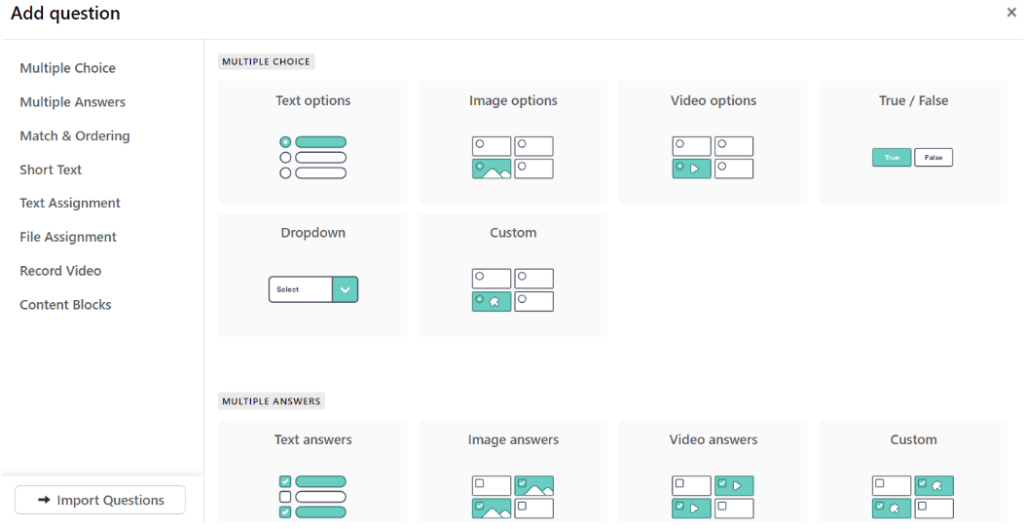
Whether you can offer these eLearning assessments online depends on the learning management system or course platform that you use to create your courses.
💡 Did you know you can now create assessments containing mathematical expressions and equations inside LearnWorlds?
Using the Math Latex text widget as supported by MathJax, you can add a mathematical expression or equation inside a question description or question option from the Assessment Builder.
This allows you to add both inline wrapped between a single $ (for example, $E=mc^2$):
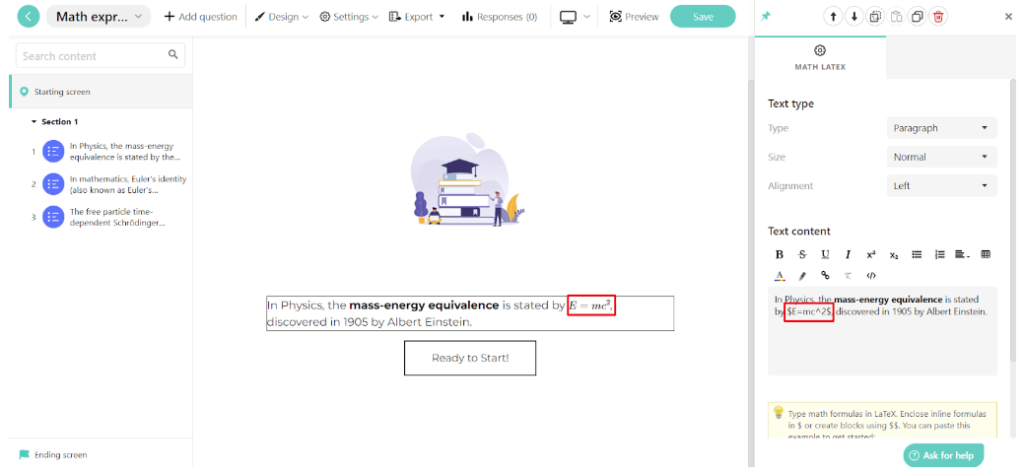
And block mathematics wrapped between $$. (for example $$ \hbar \frac{\partial}{\partial t}\Psi(\mathbf{r},t) = \hat H \Psi(\mathbf{r},t)$$).
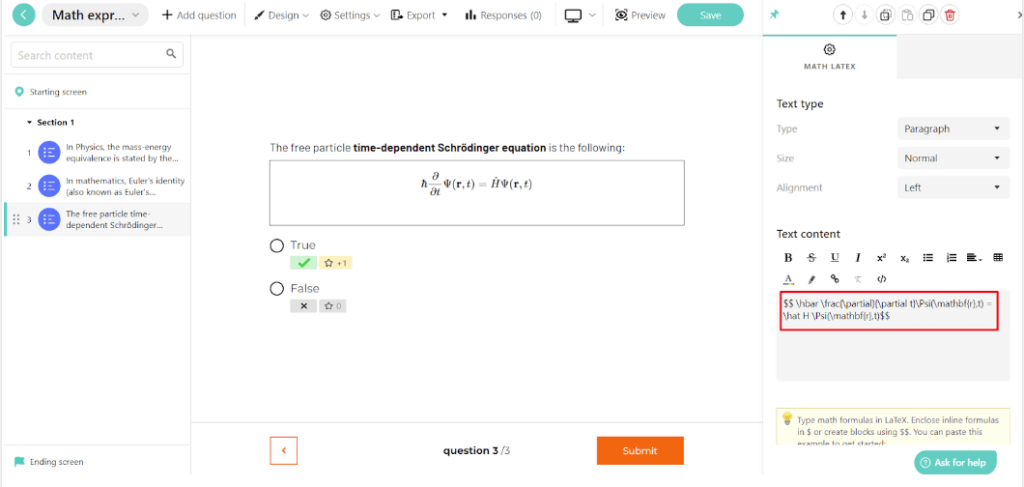
💡 Learn more about the assessment options with LearnWorlds.
As you can imagine, not every LMS provides the ability to create online quizzes, graded SCORM assignments, and interactive learning activities. Nor do they come with the online learning community-building tools you need and offer certificates providing the proper acknowledgment to your students.
A robust and intuitive LMS like LearnWorlds checks off these boxes and offers the complete package, helping you create powerful assessments and learning experiences for your learners!
4Key Types of Assessments
During the course development phase, the first thing an online instructor should be aware of is the two different forms of assessments that the educational theory indicates: the formative and summative.
Formative assessment
Formative assessment gathers information all the way throughout the course syllabus. This information is then used to guide teaching and to improve learning, student engagement, and student performance.
The key component of formative assessment is feedback, whether the assessment is a graded quiz or written assignment or student participation in a discussion forum.
Summative assessment
Summative assessment gathers and analyzes students and student interaction at the end of a course and focuses on whether students have achieved identified goals. Summative assessments typically result in a score or grade. A culminating final exam or performance task is an example of a summative assessment.
Another important term to consider is the term “Authentic assessment.” How can we bring the “real world ” into online learning? Application activities, like case studies, can be considered authentic activities.
Authentic activities demonstrate the acquisition of knowledge and the ability to apply that knowledge in professional or other settings. They become even more meaningful and contribute to student success when we call students to reflect on what they have learned instead of just giving them a set of multiple-choice questions.
You will find that learners are more engaged in your learning process activities if the activities closely align with what they aim to learn.
The Benefits of Formative and Summative Assessments
A successful online course needs to include both summative and formative assessments. Ascertaining that the desired learning goals have been met does not serve only the purpose of giving a final score to learners. On the contrary, assessment activities should be integrated into several parts of the course, providing ongoing feedback.
This means that you can include questionnaires and mini-scored exams in several modules and parts of your course, not only in the end. This kind of assessment aims to support learning until the desired level of knowledge has been achieved.
This is what the rubric of your course should look like:
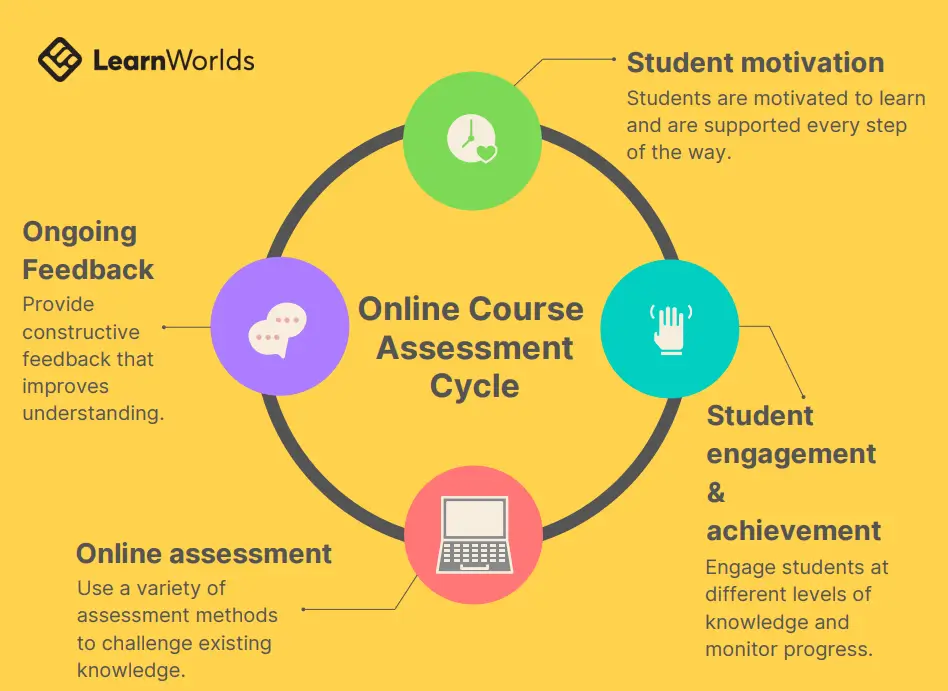
But what matters the most is that the assessment is:
These three characteristics should help you build effective formative and summative assessments while keeping you in line with the course requirements.
5The Best Way to Give Feedback
Exams and quizzes provide immediate feedback to students – particularly crucial for formative assessment. However, the most effective type of feedback for improving learning should not be directly related to your learning style but must be specific to the individual student. There is no getting around the fact that this type of accurate, timely, and meaningful feedback is labor intensive, especially when you have to comment on assignments, for example.
LearnWorlds makes it super easy to grade assessments and provide feedback right away through a dedicated dashboard – our Review Center. From there, you get a list of all the unreviewed/ungraded assessments submitted by learners.
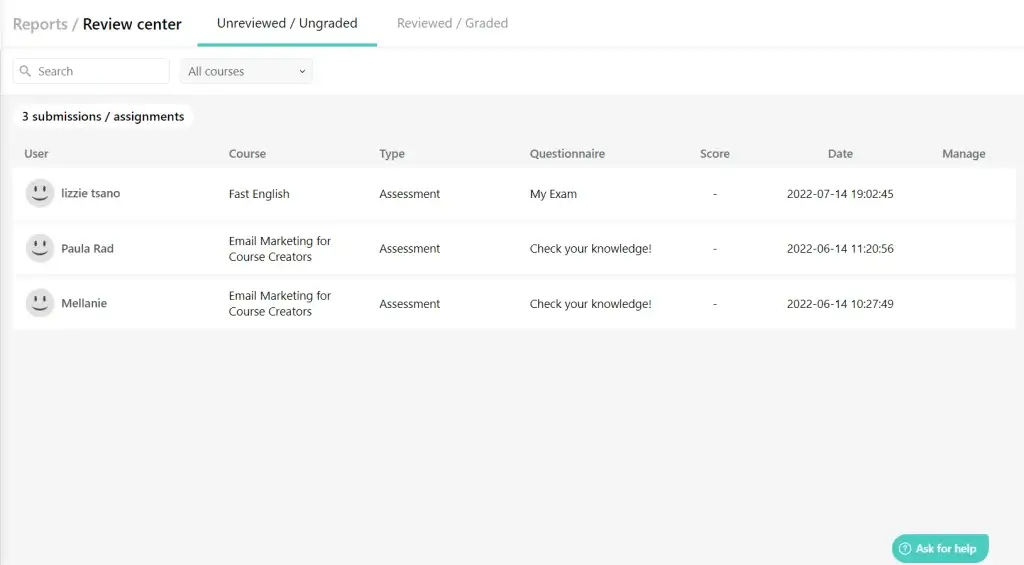
Once your learners answer a question, you can offer question-specific feedback directly through the platform.
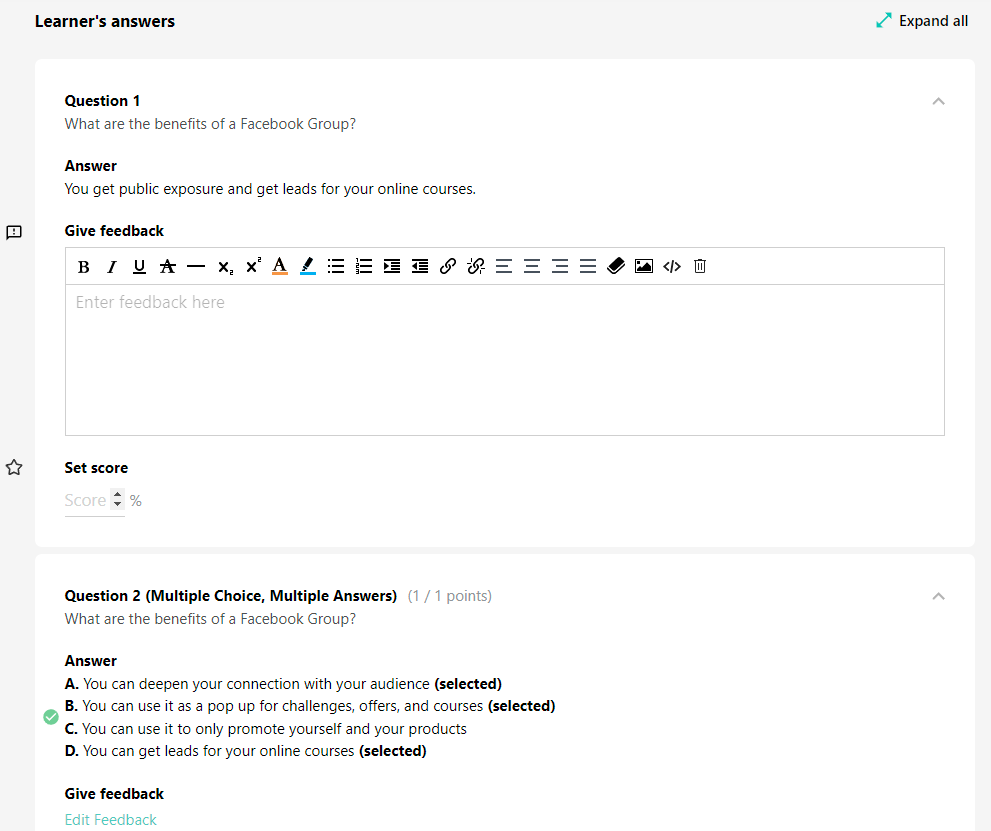
You can customize your feedback text further and write a short answer or even offer advanced feedback on either a correct or wrong answer that the learner can view from the Feedback report.
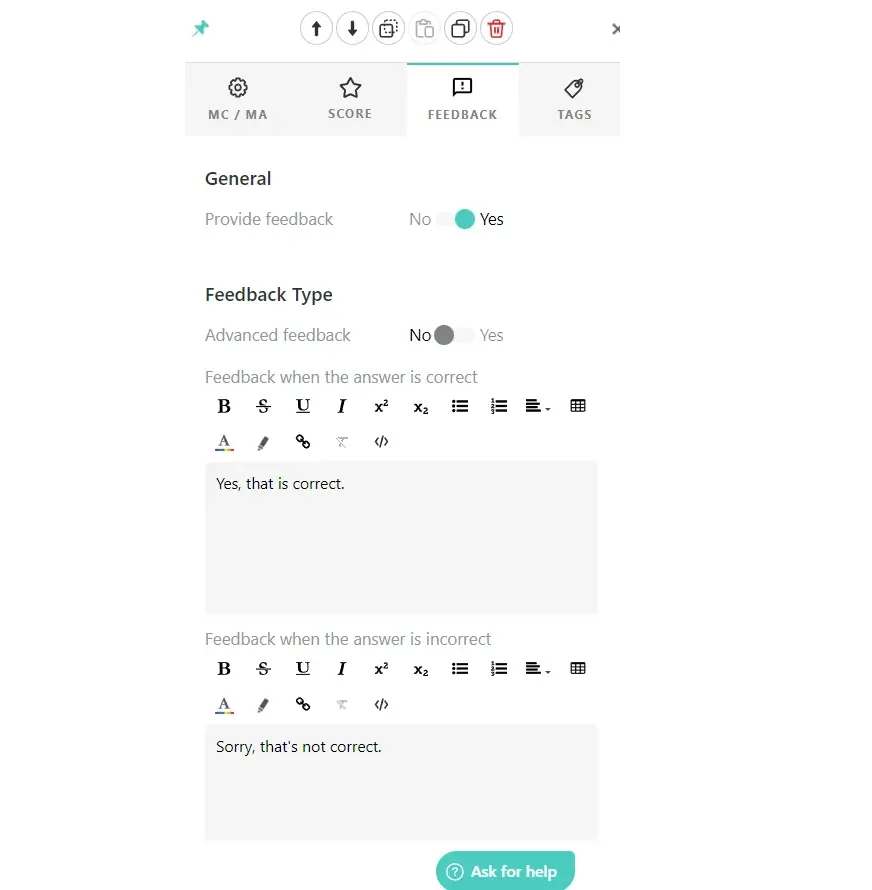
There is also the option to offer manual feedback and grade different types of assignments through the Report Center > Review Center.
💡 Learn more about what you can do with LearnWorlds’ powerful Review Center.
Apart from providing useful feedback to learners, assessment activities guide a student’s learning path; they are essential to the accreditation process as they measure student progress. Hence, assessment tasks are an active part of the study.
Learners get to use assessments to discover whether they have a good understanding of the topic and not just if they can perform competently and demonstrate what they have learned.
The feedback and grades that instructors give can be both educational and motivating for the learners. With most online learning platforms and learner management solutions being automated and interconnected, instructors can recognize the advantages of a documented, consistent assessment process, allowing educators to provide immediate feedback and help students learn.
As an added advantage, with the right LMS, instructors can save time with the automatic marking features of online assessments and use a gradebook that helps monitor progress.
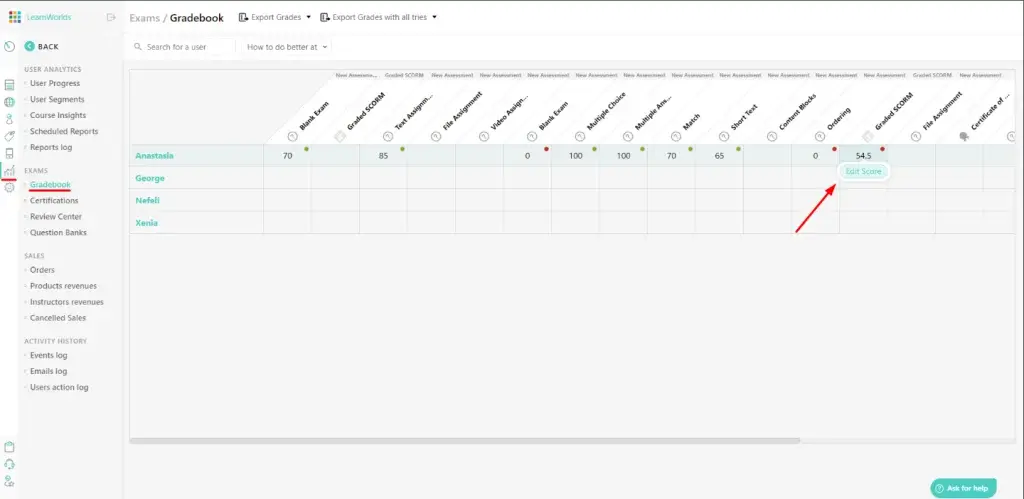
Ultimately, any form of assessment activity improves the whole assessment process in online teaching. Assessments provide flexibility, save time in the long run, and boost a consistent and standardized online course design. In addition, they virtually eliminate academic dishonesty by integrating assessments into a database of randomized items, which then allows the generation of random tests using the retrieved assessments.
6eLearning Assessment Best Practices for Online Courses
What is the best way to apply and integrate all the above into your course materials? Here is a practical guide on how you can create an assessment in your course following four crucial steps:
I. Align assessments with learning objectives
Successful course design that aligns competencies with outcomes is critical. This means that whenever you are creating a new course, it is essential to keep in mind these fundamental questions every step of the way:
Both questions will make the instructional design process much easier to begin with while ensuring you are implementing the appropriate assessment method for it.
Start by determining the required objectives for your course and come up with specific assessment activities that can show learners’ mastery of the taught subject. Given that course objectives are measurable, it is easy to design the assessments based on them.
💡 Learn how to set up your learning objectives step-by-step.
Learning goals, teaching activities, and the assessment should be aligned to reflect upon and support each other. Form questions that assess what you expect your learners to have learned by the end of the course. This is an essential facilitator and prerequisite for learner satisfaction and achievement.
II. Add assessments at every stage of course design
a) At the beginning of your course
Use quiz techniques to assess pre-existing knowledge of your learners to get to know them better and engage with them in the course. For example, you can use one of the two methods below:
Below, there is an example of an ongoing assessment that uses a quiz:
b) Throughout your course
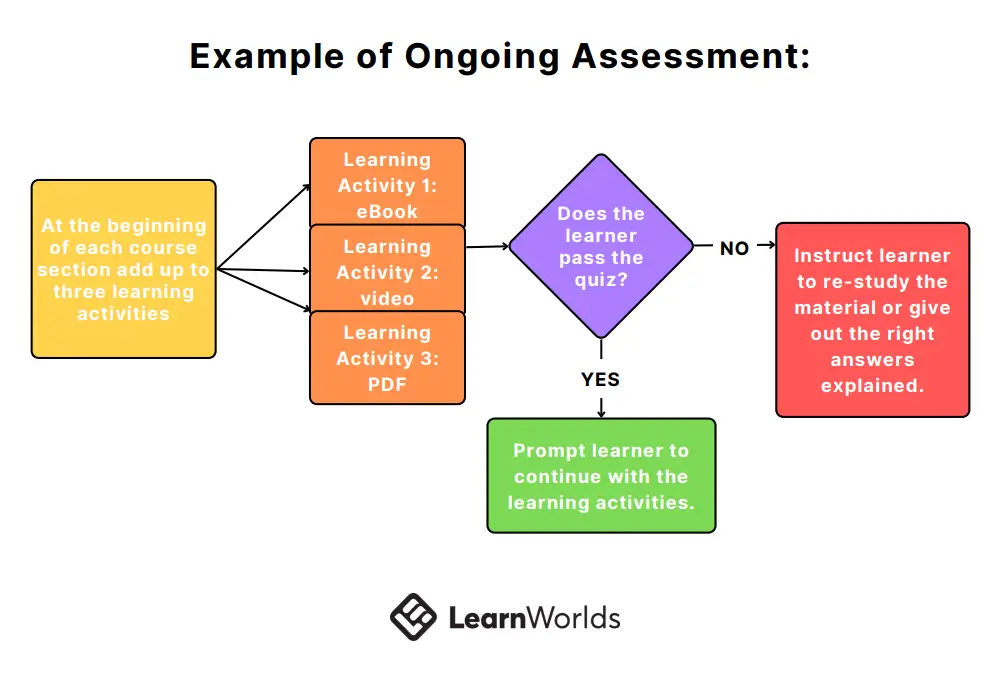
Then in the middle or throughout your course, add assignments that you can visit at any time once they are submitted and provide feedback immediately. Try something different to quizzes this time that helps you gauge understanding more easily, like questionnaires with open-ended questions, short answers, or essay questions.
When providing feedback on questionnaires inside LearnWorlds, your learners will get to receive your comments with an email and notification.

You will also be able to manage and grade those questions easily from the platform every step of the way.
c) At the end of your course
Add assessment activities at the end of the course that includes a set of questions from each of your modules. In the end, it is necessary to assess learners’ achievement based on a variety of assessment types:
In questionnaires (set as exams), you can set a higher passing score than before and congratulate learners if they pass the score. You can also choose from various options like duration in minutes, question order, number of tries, showing mistakes, etc. If they fail, prompt them to repeat the sections they struggle with. Remember always to provide meaningful, constructive feedback and expand upon the student’s learning.
Again, a modern LMS will be able to provide you with ready-made templates to help you get started with course creation and designing your own assessments.
d) Through your discussion posts
Yes, you read right. Assessment can also take place in your course discussions!
Strange, right?
Sometimes you may not be satisfied with low-stakes tests and quizzes because they are too weak and cannot assess critical thinking or enhance the learning experience. Hence, they may not adequately represent what the student has learned.
Instructors are now searching for new ways to assess learner performance during their online teaching. Much academic research has focused on learner assessment through discussions because it is a place where instructors can provide valuable feedback.

In discussion boards, you can initiate valuable learner conversations by posting several questions according to a lesson plan or create forums/groups/blackboards in your school’s community and let people discuss different topics or exchange opinions.

To do this effectively, think about how many posts per week you will use. As you go, monitor and adjust your questions to the learners’ responses so that they increase student comprehension and engagement, improving their performance.
A standard means of assessing conversations to evaluate the learning outcomes through discussions are rubrics. Rubrics are pre-defined criteria that help define the characteristics of a high–quality discussion. Rubrics also provide a range of categories that span the range of possible outcomes, from basic to exceptional performance on a task.
Let people know about your evaluation system. Write a report of your evaluation and share it with them in a private message. They will appreciate this personalized approach, and you will increase your student retention!
A rubric can look like that:
You can also use alternative assessment techniques by promoting learner contributions to the discussion board. Assist learners in creating their understanding and provide the assessment that encourages them to do something to prove knowledge acquisition rather than taking a test or quiz. Prompting learners to do something also highly contributes to the retention of knowledge gained.
“Show and tell”
Ask learners to document the steps they take for a specific project or problem-solving you have taught through your course and what they have learned. Ask them to share this document or PowerPoint with the rest of your learners. This way, you assess learning and enhance the sense of learning community in your class.
“Autobiographical sketches”
Encourage learners to write a two-page autobiographical note relating and discussing an experience in which they learned something significant related to your topic and their learning objectives. Advise them to focus on what they learned and why they learned from that particular experience and share it in the discussion.
Other products that occur through activities that assess learning and can be shared are:
“Response to video”
Learners watch a video and respond with written analysis to specific questions. Then, they share their thoughts with the rest of the learners.
“Collaborative projects”
You can ask groups of two people to collaborate, promote their creativity and produce one of the above products together. Collaborative assessment strengthens the foundation of an online learning community. By learning together, they have the opportunity to deepen their learning experience, test out and share new ideas with a supportive group, and receive critical and constructive feedback.
Although group projects, particularly the assessment of those projects, can be more challenging in the online environment, establishing collaboration and collaborative assessment guidelines can help with this task.
We can see how modern teaching opposes the one-dimensional perception of assessment as the result of tests and obtain a more holistic view that perceives assessment as an ongoing process that forms the course circle.
So, at this point, you may be asking, how should you form questions?
Outcomes and learning activities are generally created to move students from basic levels of understanding of concepts to the ability to apply those concepts in a professional or academic setting; In other words, from what is considered lower-order skills to higher-order skills.
To accomplish this, many educators have turned to Bloom’s Taxonomy of educational objectives (Bloom & Krathwohl, 1956) for assistance.

Bloom’s Taxonomy lays out levels of outcomes regarding increasing complexity, which build on one another, and to which activities and assessments can be mapped.
To write course outcomes and assessment activities that match Bloom’s levels, an instructor would determine the cognitive level of the desired outcome and then choose action verbs that measure the outcome at that level.
It cannot be overstressed that verb choice is critical to the measurement of outcomes. Αssessment questions could include the specific verbs suggested for each learning level.
Alternatively, use the sample questions shown in this table:
| Knowledge or Remembering | Comprehension | Application | Analysis | Synthesis | Evaluation |
|---|---|---|---|---|---|
| Who, what, when, where, how? | What are the main ideas? | How is…an example of…? | What are the parts or features of…? | What would you infer or predict from…? | Do you agree that…? |
| How do we define…? | Give examples of… | How is… related to …? | Classify according to… | What ideas can you add to…? | What do you think about…? |
| Why is…significant? | How does…compare or contrast with…? | How would you create or design…? | Prioritize and give a rationale for… | ||
| What evidence is there for… | What might happen if you…? | Decision making — what is your rationale…? | |||
| Criteria for assessing… |
III. Give self-assessment opportunities
Reflection and self-assessment are essential components if you want your learning environment to become even more learner-focused. What you should do is urge learners to assess themselves! Self-assessment is an exceptional technique that can increase the learners’ satisfaction.
Make sure to:
IV. Apply different assessment techniques
To check comprehension – but also engage learners more, during a live webinar class or a course discussion, you can try out a great variety of quick assessment ideas.
Here are some suggestions:
Incorporating such eLearning assessment examples in your instruction is crucial to ensure students’ understanding of the key concepts taught in your course.
As you use different techniques, make sure to change your approach from time to time, and check in for comprehension regularly, at least three times per session. Lastly, make it useful using appropriate and easily applicable real-life examples to explain key themes.
7Assessment for Learning: Last Considerations and Tips
Before you go, make sure that you read through the following suggestions. These should help you improve your course design evaluation matrix acting as your guide in perfecting assessment in eLearning:
Ready to Include Assessments in Your Online Courses?
As you can see, there are many types of assessments in online learning, and each one serves its own purpose in improving learning and students’ understanding.
The assessment of students is one of the most essential teaching strategies that need to be part of any educational program, especially those that are administered online. As a course creator, you will need to choose the assessment authoring tools that work for you and your learners and incorporate them into your teaching practice.
Creating assessments is the driving force of progress. Are you ready to embrace it, taking your eLearning evaluation process to the next level?
Further reading you might find interesting:
Kyriaki is a Content Creator for the LearnWorlds team writing about marketing and e-learning, helping course creators on their journey to create, market, and sell their online courses. Equipped with a degree in Career Guidance, she has a strong background in education management and career success. In her free time, she gets crafty and musical.


